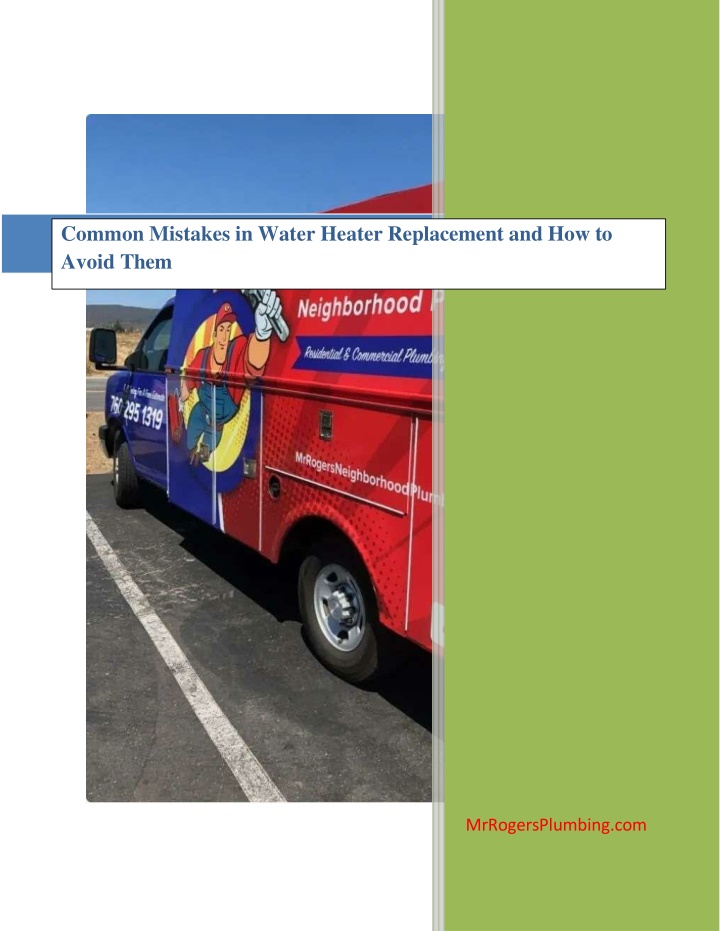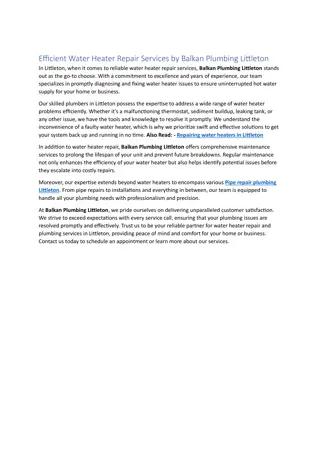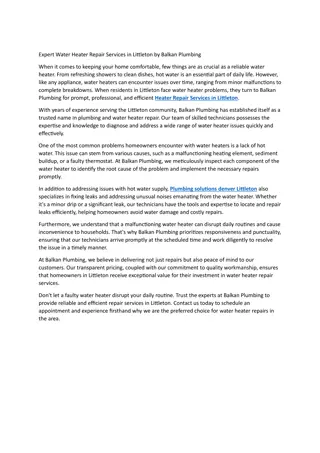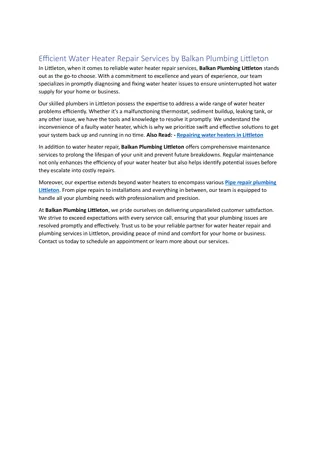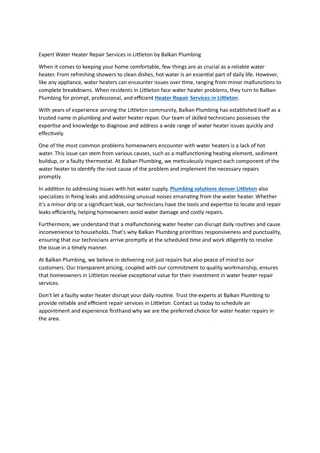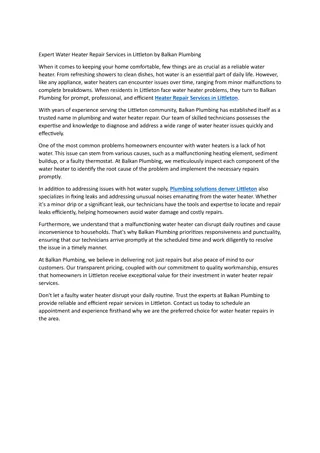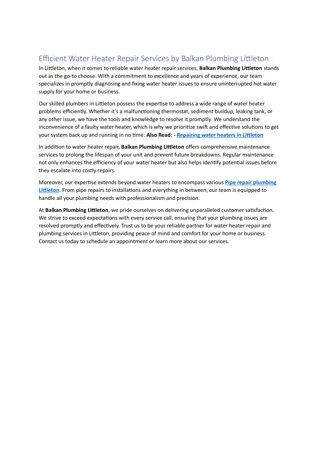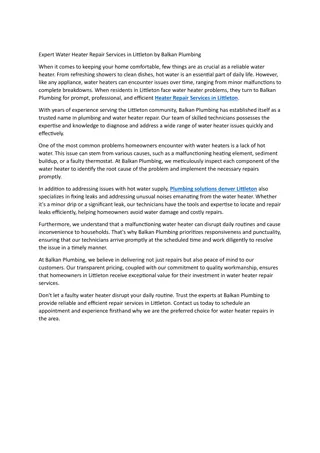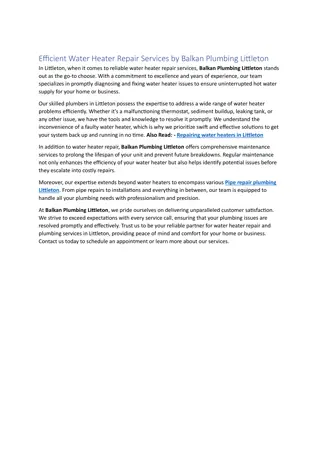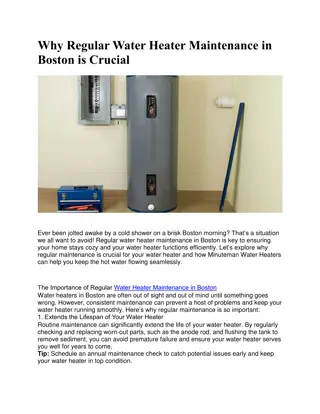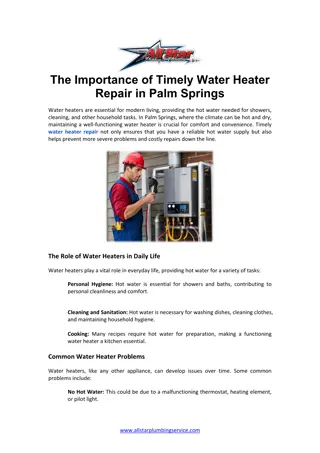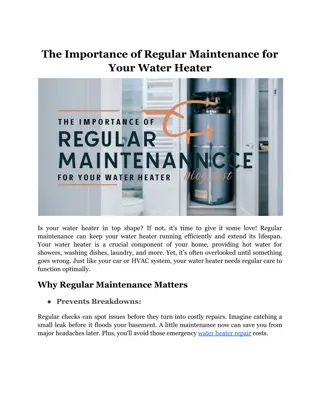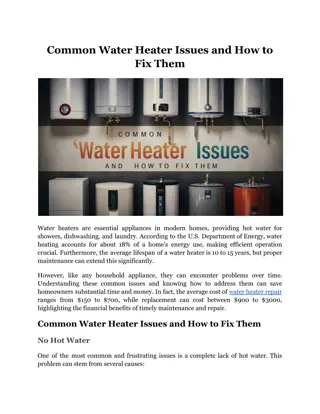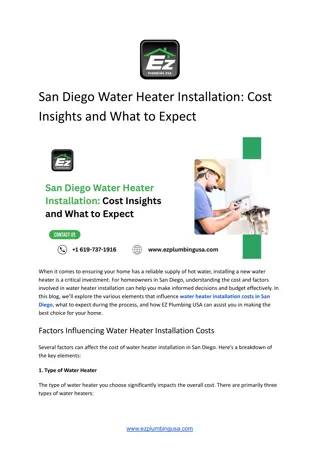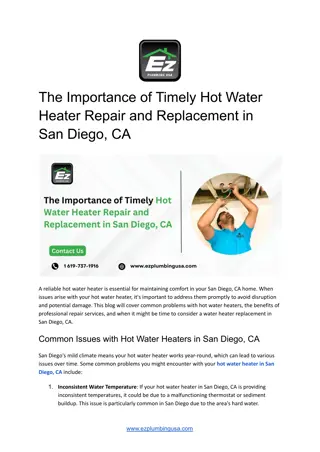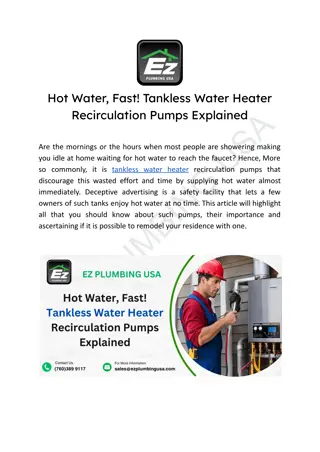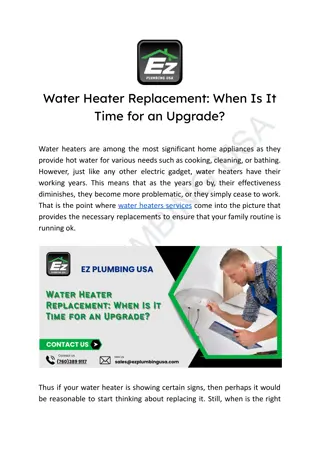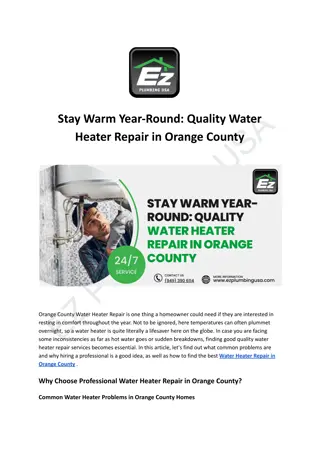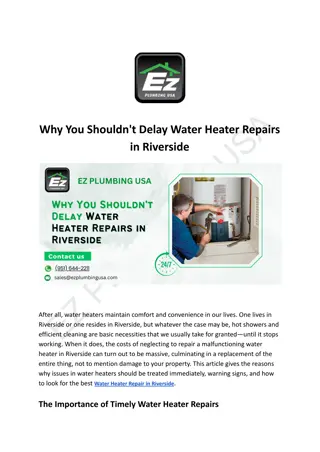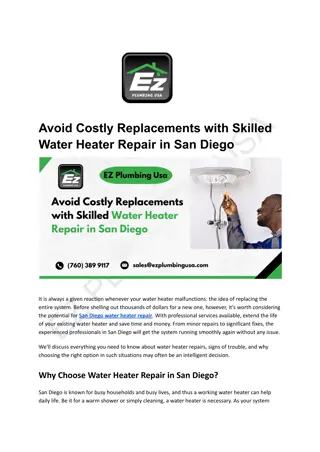Common Mistakes in Water Heater Replacement and How to Avoid Them
Avoid common water heater replacement mistakes: choose the right size, follow local codes, ensure proper ventilation, and consider insulation. For more, visit our website: //mrrogersplumbing.com/nn
Download Presentation

Please find below an Image/Link to download the presentation.
The content on the website is provided AS IS for your information and personal use only. It may not be sold, licensed, or shared on other websites without obtaining consent from the author.If you encounter any issues during the download, it is possible that the publisher has removed the file from their server.
You are allowed to download the files provided on this website for personal or commercial use, subject to the condition that they are used lawfully. All files are the property of their respective owners.
The content on the website is provided AS IS for your information and personal use only. It may not be sold, licensed, or shared on other websites without obtaining consent from the author.
E N D
Presentation Transcript
Common Mistakes in Water Heater Replacement and How to Avoid Them MrRogersPlumbing.com
Table of Contents Selecting the Wrong Size Water Heater .................................................................................................. 3 Overlooking Local Building Codes and Regulations .............................................................................. 4 Improper Ventilation in Water Heater Replacement ............................................................................... 5 Incorrect Placement of the Water Heater ................................................................................................ 6 Skipping the Expansion Tank ................................................................................................................. 8 Neglecting Proper Insulation................................................................................................................... 9 DIY Installation without Proper Knowledge......................................................................................... 10 Contact Today - Mr. Rogers Neighborhood Plumbing........................................................................... 12
Selecting the Wrong Size Water Heater Common Error: One of the most frequent errors in water heater replacement is choosing a unit that doesn't align with the household's needs either too small or too large. This mistake is particularly common as many homeowners are not familiar with the sizing requirements and depend on rough estimates. Impact: Too Small: A water heater that is too small will consistently fail to meet the hot water demands of your household. This often leads to frustration during peak usage times, such as morning routines or back-to-back shower schedules, where the supply of hot water is exhausted quickly. Too Large: Conversely, opting for a water heater that's too large for your needs results in unnecessary energy consumption and elevated utility bills. This is because a larger tank maintains a greater volume of heated water, using more energy regardless of consumption, which is inefficient and costly over time. How to Avoid: Accurate Assessment of Water Usage: The first step in selecting the appropriate size is to understand your household's average and peak water usage. Assess how many gallons of hot water you use during the busiest times and what appliances contribute to this usage. For instance, running the dishwasher, washing machine, and showers simultaneously should be considered in your calculation. Consult with an Oceanside Plumber: It s advisable to involve a professional plumber from Oceanside in this decision. Local plumbers are not only familiar with the general requirements but also understand specific local factors that might affect your water heating needs, such as water quality and climate considerations.
Consider Future Changes: If you anticipate significant changes, like more family members moving in or the installation of additional bathrooms, discuss these with your plumber to ensure the new water heater can handle future demands without frequent cycling or wastage. Overlooking Local Building Codes and Regulations Common Error: Many homeowners in Oceanside fail to adhere to the city's specific building codes and safety regulations during the installation of a new water heater. This oversight typically occurs when individuals attempt DIY installations without prior research or when using contractors who are not familiar with Oceanside's local codes. Impact: Risk of Fines: Non-compliance with local building regulations can lead to fines and penalties from local authorities, which can add unexpected costs to your installation. Safety Hazards: Improper installation can pose serious safety risks, including the potential for water leaks, electrical issues, or gas leaks if the water heater is not installed according to regulated safety standards. Insurance Issues: If your water heater is installed without regard for local codes, you may face difficulties with home insurance claims related to the water heater. Insurers often require proof of compliance with local codes for coverage of damages linked to the appliance. How to Avoid: Research Oceanside-Specific Codes: Before beginning the installation process, thoroughly research the specific building codes and safety regulations in Oceanside. The City of Oceanside's
official website and local building authority offices are valuable resources for up-to-date information. Hire a Licensed Professional: To ensure compliance and safety, consider hiring a licensed plumber who is experienced with Oceanside's building codes. These professionals are not only familiar with the legal requirements but also bring expertise in safe installation practices that comply with local standards. Permit Acquisition: In some cases, replacing a water heater may require a permit from the local building department. A licensed plumber can often handle the permit application process for you, ensuring that all work is inspected and approved as per local regulations. Improper Ventilation in Water Heater Replacement Common Error: A frequent mistake during the installation of gas water heaters is either inadequate or incorrectly installed ventilation systems. Homeowners or untrained installers might overlook the complexity of proper venting, leading to inefficient setups that do not conform to manufacturer's guidelines or safety standards. Impact: Carbon Monoxide Buildup: The most dangerous consequence of improper ventilation is the risk of carbon monoxide (CO) accumulation within the home. CO is a colorless, odorless gas that can be deadly if inhaled in large quantities. Reduced Efficiency: Inadequate venting can significantly reduce the efficiency of your water heater. An improperly vented gas water heater struggles to combust fuel efficiently, which can increase gas consumption and operational costs. Potential Safety Risks: Beyond carbon monoxide risks, improper ventilation can lead to other safety hazards, including fire risks and deterioration of indoor air quality.
How to Avoid: Follow Manufacturer Guidelines: Always adhere to the manufacturer's installation instructions regarding ventilation. These guidelines are designed to maximize the safety and efficiency of your water heater by specifying the type and size of venting required. Hire a Professional: Given the high stakes involved with gas appliances, it's advisable to hire a professional plumber or HVAC technician for installation. A certified expert in Oceanside will be familiar with local codes and manufacturer specifications for proper ventilation. Regular Inspections: After installation, periodic checks by a professional ensure that venting remains clear and functional over time. This is crucial as vents can become obstructed or deteriorate, which could revert the system to an unsafe state. Incorrect Placement of the Water Heater Common Error: A frequent mistake during water heater installation is placing the unit in an unsuitable location. Common inappropriate places include cramped spaces, areas with poor ventilation, or locations prone to environmental hazards like flooding. This misstep often occurs when trying to utilize existing connections or spaces without evaluating the new unit's specific requirements. Impact: Maintenance Challenges: Installing a water heater in a cramped space can make regular maintenance such as flushing the tank, checking the anode rod, and inspecting for leaks difficult. These maintenance activities are essential for extending the lifespan of the unit and ensuring efficient operation.
Increased Risk of Damage: Placing a water heater in an area prone to flooding or environmental extremes can lead to premature wear and damage. For example, units placed in flood-prone areas may suffer from water damage that could compromise system integrity and efficiency. Potential Safety Issues: Incorrect placement can also lead to safety hazards, such as difficulty in quickly shutting down the unit in an emergency or inadequate ventilation leading to harmful emissions. How to Avoid: Accessible Location: Choose a location for your water heater that allows easy access for maintenance and emergency shutoff. Ensure there is enough space around the unit for a person to perform necessary inspections and repairs. Well-Ventilated Area: Especially crucial for gas water heaters, the selected location must have proper ventilation to prevent the buildup of dangerous gases like carbon monoxide. Follow manufacturer guidelines and local codes to determine the specific ventilation needs of your unit. Safe from Hazards: Avoid areas that are susceptible to environmental hazards such as flooding or excessive heat. Evaluate potential risks in your chosen installation site in Oceanside, CA, to prevent environmental conditions from affecting the unit s operation and longevity. Consult with Professionals: Engage a licensed plumber or HVAC technician who understands local Oceanside building codes and environmental factors. They can provide valuable insights into the best placement for your water heater, enhancing safety and efficiency.
Skipping the Expansion Tank Common Error: A common oversight during water heater replacement is failing to install an expansion tank when required. Homeowners or installers might neglect this component because they are either unaware of its importance or trying to cut costs. Impact: Excessive Pressure Buildup: Without an expansion tank, the normal thermal expansion of water as it heats can create additional pressure in the plumbing system. This pressure must go somewhere, and without the proper outlet, it can strain your water heater and associated piping. Potential Damage: The excessive pressure can lead to premature wear and tear on your water heater, pipes, and fittings. In severe cases, it could cause leaks or even catastrophic failures, posing serious risks to your home and safety. Warranty Issues: Many water heater manufacturers require an expansion tank in their installation guidelines. Skipping this step could void warranties and leave you financially responsible for any related damages or malfunctions. How to Avoid: Assess the Necessity: The first step is to determine if an expansion tank is necessary for your home s plumbing system. This assessment usually depends on whether you have a closed plumbing system where backflow into the main water supply is prevented by a check valve or pressure reducing valve. Understand Local Codes: Oceanside has specific building codes that might require an expansion tank as part of your water heater installation. Familiarize yourself with these requirements to ensure compliance and safety.
Professional Consultation: Consult with a licensed plumber in Oceanside to evaluate your system s needs. A professional can provide valuable advice on the size and type of expansion tank necessary for your new water heater, ensuring it matches the system s capacity and local code requirements. Installation by Experts: It s advisable to have the expansion tank installed by professionals. Proper installation not only complies with local codes but also integrates seamlessly with your plumbing system, ensuring functionality and longevity. Neglecting Proper Insulation Common Error: A frequent oversight during the installation of new water heaters is failing to insulate the water heater and the surrounding pipes adequately. This oversight is usually due to a lack of awareness about the benefits of insulation or a desire to speed up the installation process. Impact: Increased Heat Loss: Without proper insulation, heat escapes more readily from both the water heater and the pipes, leading to significant energy inefficiency. Reduced Efficiency: The water heater has to work harder and longer to maintain the desired water temperature, which strains the system and can shorten its lifespan. Higher Energy Bills: The more energy required to heat the water, the higher your bills. Inadequate insulation results in increased energy consumption, which directly impacts your monthly utility costs.
How to Avoid: Install Adequate Insulation: When replacing your water heater, ensure that both the tank and the first few feet of both the hot and cold pipes are well-insulated. This is particularly important if the water heater is located in an unconditioned space such as a garage or basement where exposure to external temperatures can be significant. Use Recommended Materials: Use insulation materials recommended by energy experts, such as foam pipe insulation for pipes and an insulating blanket for the tank. These materials are designed to withstand high temperatures and effectively reduce heat loss. Consult with Professionals: A professional plumber in Oceanside can provide valuable guidance on the best types of insulation for your specific setup and local climate conditions. They can also ensure that the insulation is installed correctly, covering all necessary areas without obstructing vents or controls. Follow Local Energy Codes: Oceanside may have specific requirements or recommendations for energy efficiency, including insulation standards. Adhering to these codes not only ensures compliance but can also qualify you for energy rebates or savings programs. DIY Installation without Proper Knowledge Common Error: Many homeowners in Oceanside attempt to replace their water heaters on their own without fully understanding the complexities of the task. This often stems from a misconception that water heater installation is straightforward and merely requires physical labor.
Impact: Potential Safety Hazards: Water heater installation involves dealing with electrical wiring, gas lines, or plumbing, each of which can pose serious risks if not handled correctly. Mistakes can lead to gas leaks, water damage, electrical fires, or even physical injuries. Improper Installation: Without the proper technical know-how, the installation may not meet local building codes or manufacturer s specifications. This can result in inefficiencies and frequent breakdowns, impacting the longevity and performance of the new unit. Voided Warranties: Most water heater manufacturers require installation by a certified professional for the warranty to be valid. A DIY installation might void these warranties, leaving you financially responsible for any faults or malfunctions. How to Avoid: Hire a Professional Plumber: The safest way to ensure that your water heater is installed correctly is to hire a professional Oceanside plumber. Licensed plumbers have the required knowledge, skills, and tools to install water heaters safely and efficiently. Check Credentials: Make sure the plumber you hire is licensed and insured in California. This not only guarantees a certain level of expertise but also provides you with protection against possible damage and liability. Understand Local Codes: A professional plumber will be familiar with the specific building codes and safety regulations in Oceanside. This compliance is crucial for both safety and legality, ensuring that your installation adheres to local standards. Ask for a Warranty: When a professional installs your water heater, ask about service warranties that come with the installation.
Contact Today - Mr. Rogers Neighborhood Plumbing Address 4061 Oceanside Blvd Suite E, Oceanside, CA 92057, United States Phone Number 760-938-6867 Business Hours 7 Days - 7 AM 8 PM Website https://mrrogersplumbing.com/
